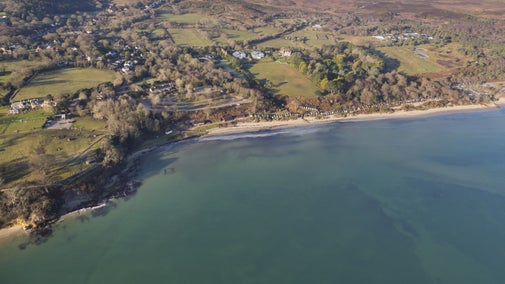
Discover more at Studland Bay
Find out how to get to Studland Bay, where to park, the things to see and do and more.

Studland Bay is known to many as a leisure destination boasting four miles of beach, but its historical significance is often overlooked. Discover how Studland Bay was used for military operations during the Second World War and how it came to be donated to the National Trust in 1981.
In 1944 Studland Bay was used to host Exercise Smash, a full-scale dress rehearsal for the Allied invasion of Europe. Using live ammunition, the exercise was overseen by The King and Sir Winston Churchill and lessons learned here had a direct impact on the success of the D-day landings.
We ask for your permission before anything is loaded, as this content may introduce additional cookies. You may want to read the Google YouTube terms of service and privacy policy before accepting.

Live World War Two ammunition may occasionally be found. If you see anything, do not touch or remove it but note the location using what three words and report it immediately to a member of staff or call 01929 450500 or the police on 999.
Exercise Smash, a full-scale dress rehearsal for the Allied invasion of Europe, took place in Studland Bay in April 1944. Many duplex-drive Valentine tanks were used during the exercise.
The duplex tanks were modified versions of the existing Valentine model which had propellers and a fabric ‘skirt’ added so they could be launched from offshore as part of the assault on the Normandy beaches.
Look out for the concrete anti-tank defences known as Dragon’s Teeth, placed between Middle beach and Fort Henry. These huge concrete posts form part of the defence against an enemy invasion. More of these can be found further up the coast at Bramble Bush Bay near Shell beach.
Then Prime Minister Sir Winston Churchill and Allied Supreme Commander, Dwight D Eisenhower, watched Exercise Smash from Fort Henry above Middle Beach.
You can still visit Fort Henry today and view the bay just as Churchill did. Follow the South West Coastal Path from the car park at Middle Beach.
Tragically, on 4 April 1944 many of the amphibious tanks sank and six lives were lost. A memorial to those who died stands alongside Fort Henry.

The aristocratic Bankes family, who once owned Corfe Castle and Kingston Lacy spent summers at their Studland residence, now a popular hotel called ‘The Pig on the Beach’.
The summer residence was ideally placed to gain easy access to the sandy beach. Henrietta Bankes and her son Ralph frequently spent time as a family on the beach.
On his death in 1981 Ralph Bankes bequeathed the Bankes estate, including Studland, Corfe Castle and Kingston Lacy, to the National Trust.
Studland beach and its dunes haven’t always existed. Sand began being deposited on the eastern shore of the Studland peninsula only about 500 years ago.
The beach today is just the seaward edge of a dune system that’s been growing ever since.
It was this growth that formed a barrier that created Little Sea, a freshwater lake that’s separate from the sea. The dunes are still growing. In fact, the dunes are growing at more than one metre per year at the northern end of the peninsula.
Dunes are formed as wind blows sand up from the beach into mounds and ridges. They continue to blow around until they’re stabilised by the dune marram grass.
The Studland dunes are unusual as they’re made of acidic sand with very low shell content.

Find out how to get to Studland Bay, where to park, the things to see and do and more.
Explore the four miles of beautiful beaches that line the sheltered waters of Studland Bay, making it ideal for family beach trips and coastal exploration.

Discover what’s on the menu at Knoll Beach Café, where you can sit and sip while enjoying sea views, then pop into the shop for a treat to take home.

Catch up on how Dynamic Dunescapes, a nationwide project to restore sand dune landscapes to improve the habitat for nature, is progressing at Studland Bay.
Learn about people from the past, discover remarkable works of art and brush up on your knowledge of architecture and gardens.

A designated section of Studland Beach is probably the best known naturist beach in Britain. The 900m area of Knoll Beach is marked with signs and posts.

Studland Bay is a two pawprint rated place. Well-behaved dogs are very welcome. We have certain restrictions to ensure everyone enjoys the beach, whether on two or four feet.

Studland Bay is a special landscape that dedicated teams of staff, volunteers (and a herd of cattle) help maintain for the safety and enjoyment of wildlife and visitors.

Volunteers play a big part in caring for habitats and helping visitors across Purbeck and we are always looking for friendly and passionate people to join our teams.
